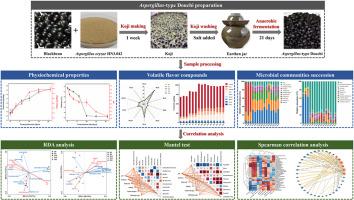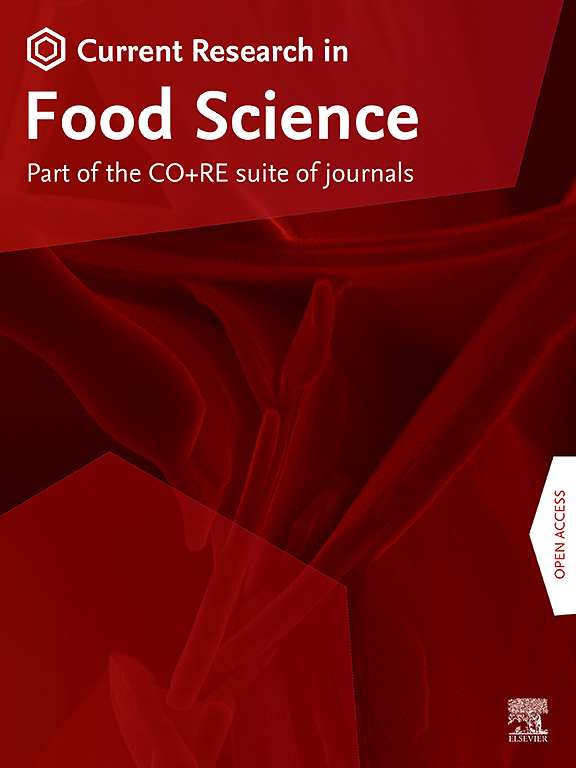Unraveling the correlation between physicochemical properties, volatile flavor compounds, and microbial communities during the fermentation of Aspergillus-type douchi
IF 7
2区 农林科学
Q1 FOOD SCIENCE & TECHNOLOGY
引用次数: 0
Abstract
As a traditional fermented food, Aspergillus-type Douchi develops its characteristic flavor through natural fermentation in a semi-open environment. However, the extensive production methods traditionally employed for Aspergillus-type Douchi often result in inconsistent quality and increased contamination risks. This study utilized headspace solid-phase microextraction coupled with comprehensive two-dimensional gas chromatography-mass spectrometry and high-throughput sequencing techniques to elucidate the dynamic succession of volatile flavor compounds and microbial communities during the fermentation of Aspergillus-type Douchi. The results demonstrated that the total organic acid content increased steadily from 23.33 mg/g to 64.03 mg/g, predominantly comprising succinic acid, lactic acid, and citric acid. Free amino acid levels exhibited an initial rise followed by a decline, with umami amino acids consistently dominating. Alcohols, esters, aldehydes, and acids were the predominant flavor compounds in Aspergillus-type Douchi, with 36 identified as key volatile flavor compounds (VIP >1, p < 0.05). In the microbial community, bacterial communities dominated by Firmicutes, Proteobacteria, and Bacteroidota were the principal fermenting microbiota, whereas fungal communities were predominantly composed of Ascomycota. Correlation analysis results indicated that pH and total acidity were the primary environmental factors influencing bacterial communities, while amino acid nitrogen significantly impacted fungal communities. Furthermore, Corynebacterium, Bacteroides, Wickerhamomyces, Bacillus, Lactobacillus, and Staphylococcus exhibited highly significant positive correlations with at least four key volatile flavor compounds, suggesting their roles as core functional microbiota shaping the distinctive flavor profile of Aspergillus-type Douchi. This research provids a theoretical foundation for targeted quality control and the screening of novel fermentation cultures for Aspergillus-type Douchi.

揭示曲霉型豆豉发酵过程中理化性质、挥发性风味化合物和微生物群落之间的关系
曲霉菌型豆豉是一种传统的发酵食品,在半开放的环境中通过自然发酵形成其特有的风味。然而,传统上广泛采用的曲霉型豆豉生产方法往往导致质量不稳定,污染风险增加。本研究利用顶空固相微萃取结合二维气相色谱-质谱联用技术和高通量测序技术,研究了曲霉型豆豉发酵过程中挥发性风味物质和微生物群落的动态演替。结果表明:总有机酸含量由23.33 mg/g稳步上升至64.03 mg/g,主要以琥珀酸、乳酸和柠檬酸为主;游离氨基酸水平呈现先上升后下降的趋势,鲜味氨基酸占主导地位。曲霉型豆豉的主要风味成分为醇类、酯类、醛类和酸类,其中36种为主要挥发性风味成分(VIP >1, p < 0.05)。在微生物群落中,以厚壁菌门、变形菌门和拟杆菌门为主的细菌群落是主要的发酵菌群,而真菌群落以子囊菌门为主。相关分析结果表明,pH和总酸度是影响细菌群落的主要环境因子,而氨基酸氮对真菌群落的影响显著。此外,棒状杆菌、拟杆菌、Wickerhamomyces、芽孢杆菌、乳酸杆菌和葡萄球菌与至少四种关键挥发性风味化合物表现出高度显著的正相关,表明它们是塑造曲霉型豆豉独特风味特征的核心功能微生物群。本研究为曲霉型豆豉有针对性的质量控制和新型发酵培养物的筛选提供了理论依据。
本文章由计算机程序翻译,如有差异,请以英文原文为准。
求助全文
约1分钟内获得全文
求助全文
来源期刊

Current Research in Food Science
Agricultural and Biological Sciences-Food Science
CiteScore
7.40
自引率
3.20%
发文量
232
审稿时长
84 days
期刊介绍:
Current Research in Food Science is an international peer-reviewed journal dedicated to advancing the breadth of knowledge in the field of food science. It serves as a platform for publishing original research articles and short communications that encompass a wide array of topics, including food chemistry, physics, microbiology, nutrition, nutraceuticals, process and package engineering, materials science, food sustainability, and food security. By covering these diverse areas, the journal aims to provide a comprehensive source of the latest scientific findings and technological advancements that are shaping the future of the food industry. The journal's scope is designed to address the multidisciplinary nature of food science, reflecting its commitment to promoting innovation and ensuring the safety and quality of the food supply.
 求助内容:
求助内容: 应助结果提醒方式:
应助结果提醒方式:


